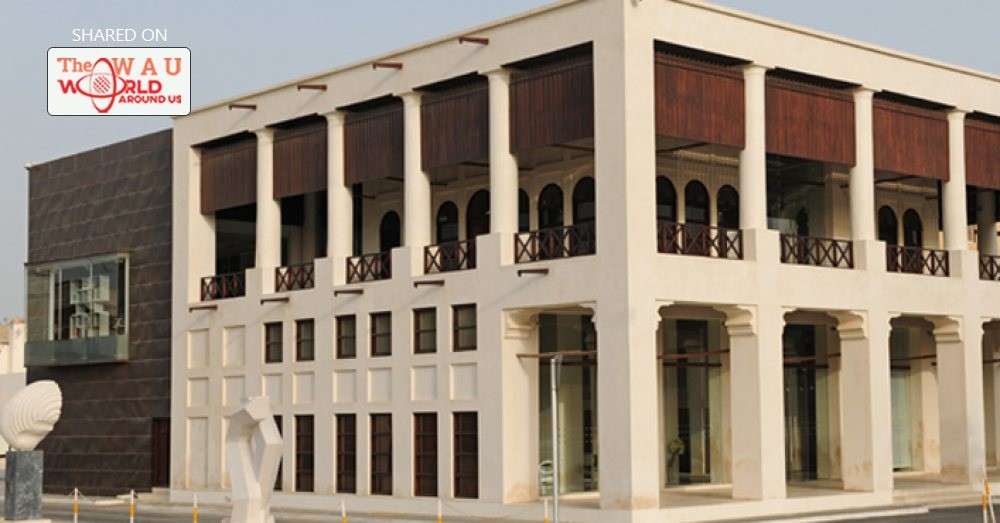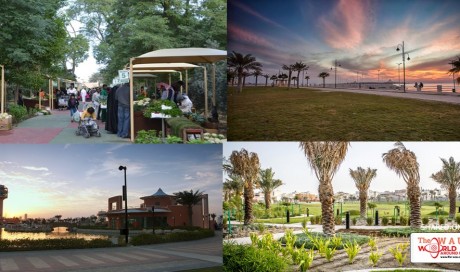Bahrain National Museum
The Bahrain National Museum is the crowning achievement of the Kingdom of Bahrain’s ongoing efforts to preserve the nation’s heritage and history; Efforts which began in 1957 when the first exhibition of the artefacts discovered by the Danish archaeological expedition was held at Al-Hidaya Al-Khalifiya in Muharraq.
The museum was inaugurated in 1988 by the late Emir Shaikh Isa bin Salman Al Khalifa in a grand ceremony attended by His Royal Highness Prince Khalifa bin Salman Al Khalifa, the Prime Minister, and then Crown Prince His Majesty King Hamad bin Isa Al Khalifa.
Built on a central location between Manama and Muharraq, Bahrain National Museum houses 9 main halls, and classifies the accumulated heritage of the Kingdom of Bahrain into 6 different sections. Visitors to the museum will be taken on a 4,000 year journey through time as they pass through its halls, from the traditional handicrafts hall, to the customs and traditions hall, burial mounds hall, ancient documents and manuscripts hall, Tylos hall, and Islamic period hall.
The museum seeks not only to enhance understand and knowledge of Bahrain’s history amongst locals only, but also play a role as an institutions which promotes global culture within the community, as evidenced by the numerous international culture and art exhibitions it has hosted over the years.

Bahrain's Forts
Bahrain Fort (Qalat al Bahrain)
Known as Dilmun in ancient times, Bahrain’s rich trading history is reflected in numerous archaeological digs around the island. Qalat al-Bahrain site (Bahrain Fort site) is among the most exciting of them and is registered as a UNESCO World Heritage Site.
The fort is located atop a 17.5 hectare artificial hill that has been built while enduring over 4,000 years of continuous occupation. It is also the site of the former capital of Dilmun and is one of the most prolific archaeological digs in the Arabian Gulf. Excavations over the past 50 years have revealed residential, public, commercial, and military structures that testify to the importance of that location over the centuries.
Open to the public since 2008, the site museum display area consists of 5 exhibition halls organized around the massive Tell Wall with over 500 artifacts showcased and many interesting layers of its historical legacy have been revealed which is further highlighted with the use of an audio guide available to visitors.
Arad Fort
Strategically located as a sea passage, Arad fort is a typical example of Omani military architecture at the end of the 15th and early 16th centuries. This fort was once the site of fierce battles and underwent different construction phases. All though it is not clear when it was constructed it has played a major role in the defence of Bahrain against marauders through the centuries. It was restored in the 1980s using only authentic material. It is nicely illuminated at night and hosts seasonal festivals throughout the year.
Shiekh Salman Bin Ahmed Al Fateh Fort (Riffa Fort)
Sheikh Salman bin Ahmed Al-Fateh Fort, commonly known as Riffa Fort due to its location in Riffa, is an historic landmark and stands witness to one of the most important junctures in Bahrain’s history. Within its beautiful architecture lives the memory of the ruling family of Bahrain, the Al Khalifas.
A series of programs organized by the Ministry of Culture have brought life back to the fort and not only present a chronological history of the Al Khalifa family but showcase the interior space designed by the French firm, La Meduse and the local engineering firm, PAD, which took its inspiration from the fort’s history and people.
Bu Maher Fort
Bu Maher Fort is located in the south of the city of Muharraq, and was first built during the Portuguese occupation of Bahrain. Renovation works on the fort commenced in the 1970’s, during which only some of it was rebuilt. In 2010, excavation works carried work at the site uncovered its original foundations and dimensions.
The fort represents the first step on Pearling Trail, which the Ministry of Culture succeeded in inscribing as a World Heritage Site in 2012. A dedicated visitor centre was established next to the fort which houses an illustrated map of the Pearling Trail and models of the sites that can be found along the way.
The Bu Maher Fort visitor centre aims to introduce the public to the architectural character that went hand in hand with the traditional pearling trade, as well as highlighting its surrounding environment both within Bahrain and beyond, and building an understanding of the social components of that era.

Bahrain's Traditional Houses
Abdullah Al Zayed House for Bahraini Press Heritage
The newly restored 100-year old building opened in November 2003. Being the house of the founder of the first weekly newspaper in Bahrain and the Gulf, the house is dedicated to the preservation of Bahrain’s press heritage and at the same time preserves part of the country’s unique architectural traditions.

Bait Khalaf
Memory of the place for Manama pearl merchants one of the unique traditional houses of Manama presented by Khalaf family.
Bin Faris House for Sut Music
The Mohammed bin Faris Sut Music House was opened on 12 September, 2005 as a museum commemorating the achievements of the Bahraini singer and musician Mohammed bin Faris.Mohammed bin Faris was a master of a type of music that originated in the Arabian Gulf region, the Sut. Through his own compositions and mastery of the art form, Mohammed bin Faris brought Sut music to new heights and gave it a particularly Bahraini form.

Bin Matar House
The Bin Matar House was built on reclaimed land in 1905 and at the time was surrounded by the sea on three sides. Supervised by the Bahraini master builder Mussa bin Hamad, the building was constructed in a traditionally Bahraini manner, using palm tree trunks, sea-stone and gypsum.The building was initially used as the permanent majlis of Salman Hussein Bin Matar, one of Bahrain’s the most prominent pearling merchants. Even as the building was eventually used as a clinic for the famous Dr. Banderkar and home of the Al Eslah Club, the top floor was retained as a residence by the Bin Matar family until 2002.

Ibrahim Al Arrayed House for Poetry
The Ibrahim Al Arrayed House of Poetry was built in the mid-20th century in the Bahraini colonial style. It was located on the famous Palace Road, leading directly to the Shaikh Hamad palace. Ibrahim Al Arrayed acquired the building and lived there until the late 1970s.
The Ibrahim Al Arrayed House is dedicated to the art of poetry, which plays a central cultural role in this region. It is named after the famous Bahraini poet Ibrahim Al Arrayed, who was Bahrain’s foremost figure in poetry and literature for over half a century. Opened on 3 April, 2006, the House of Poetry has become a cultural centre for events relating to poetry. It also houses a large collection of books and works by the foremost figures in the field of poetry of the region, forming a base for researchers and lovers of poetry.

Kurar House
Kurar is a form of embroidery using a golden thread. The Kurar ribbon is created amongst a minimum of three women at a time and immediately embroidered onto a garment. After the Kurar ribbon is completed and sown onto a garment, it is burnished to give it its characteristic shine and final touch. The Kurar House was established on 12 March 2007 to preserve the dying and unique Bahraini art of Kurar embroidery. The building provides a venue for elderly Bahraini ladies to pass on the art of the Kurar to younger generations.

Nukhidhah House
The Nukhidhah house is one of the houses located on the “Pearl Walk”, as a part of the project “Pearling and its cultural landscapes in Bahrain”.

Shaikh Ebrahim Bin Mohammed Al-Khalifa Centre for Culture and Research
On 12 January, 2002 the Shaikh Ebrahim bin Mohammed Centre for Culture and Research opened its doors once again as a forum for debate and exchange on current cultural, social and political issues. Built on the land of the original majlis of Shaikh Ebrahim bin Mohammed Al Khalifa, the current building is a modern reconstruction.

Sheikh Isa Bin Ali House
The House of Sheikh Isa bin Ali Al Khalifa was his residence and the seat of his government. This beautiful house offers insight into the royal life in the 19th century. It consists of several rooms arranged around four courtyards and characterized by its wind towers. It is considered one of the most impressive example of Gulf Islamic architecture on the island.
Siyadi House
The house of Ahmed bin Jasim Siyadi, a former well-known pearl merchant in the 19th century, is a beautiful example of a historic style building that Muharraq is known for. Its three story façade features uniquely curved corners and beautiful stucco work. The house is part of a larger complex of buildings that contain a mosque and majlis. The house is included in the “Pearling: Testimony of an Island Economy” project and was designated a UNESCO World Heritage Site in 2012.

Bahrain's Mosques
Al Fateh Grand Mosque
The grand Al Fateh Mosque is both Bahrain’s largest place of worship and among one of the largest mosques in the world. It was built under the patronage of the late Sheikh Isa bin Salman Al Khalifa in 1987 and was named after Ahmed Al Fateh. The mosque accommodates up to 7000 worshippers and is crowned with the largest fiberglass dome in the world. The walls of the mosque are beautifully ornamented with Kufic calligraphy.
Al Khamis Mosque
Built around 692 AD, Al Khamis Mosque is one of the oldest mosques in the Arab world. The identical twin minarets on this ancient Islamic monument make it easily recognizable. The foundation dates back to the 11th century and has been rebuilt in the 14th and 15th centuries. During this reconstruction the twin minarets were added.
Siyadi Mosque
Part of the Siyadi House complex, which belonged to a former eminent pearl merchant in the 19th century, the Siyadi Mosque is the oldest preserved mosque in Muharraq and is still used for daily prayers.

Dilmun Burial Mounds
Bahrain has what is believed to be the largest prehistoric cemetery in the world. Amongst its mysterious ancient remains are the thousands of burial mounds that dominate the landscape north of the Island. Spanning the Dilmun era (3rd to 1st millennium BC) to the Tylos era (200 BC to 300 AD) the burial mounds are unique in terms of sheer number and concentration. The best preserved and most impressive mounds are the royal burial mounds in the village of A’ali.
Pottery workshops in the vicinity of the mounds have developed organically over the years allowing the artisans to incorporate their installations around the tombs and even using burial chambers as kilns.

Barbar Temple
The Barbar complex consists of three successive temples built over 5 stages and dating back to the 2nd and 3rd millennium BC. They were built on platforms, organized around a courtyard and thought to have been constructed to worship gods. A sunken chamber enclosing a fresh water spring constitutes the focus of a cult believed to be associated with the Mesopotamia God of wisdom and sweet water Enki.

Share This Post















